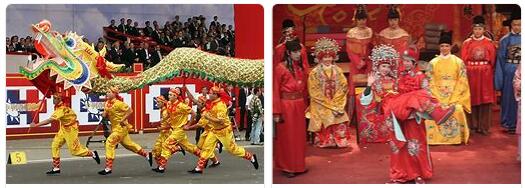Architecture
Chinese architecture is characterized by distributing space in rectangular units that come together to form a whole. The rectangular shape was also used in Greek temples, but the effect was austerity. The Chinese style, on the other hand, combines rectangles of different sizes and in different positions according to the importance of the organization of the whole. The different levels and elements are clearly distinguished. The result is an impressive exterior, but at the same time dynamic and mysterious.
In traditional Chinese architecture, the distribution of spatial units is governed by the principles of balance and symmetry. The shaft constitutes the main structure. The secondary structures are located on both sides of the axis forming the central courtyard and the main rooms. Both houses and official buildings, temples and palaces conform to this fundamental principle. In the distribution of the interior space, the ethical and social values of the Chinese are reflected.
Chinese houses
Both nest houses like caves dwellings are the most primitive forms of Chinese traditional folk houses. Among all the models of traditional Chinese houses, patio-type houses with rooms are the most common and also those built with better quality materials and advanced structural technology, with richer compositional factors, and more varied arrangements and decorations.
These houses have many variations, for example, the calls ” a seal “, that come from the caverns, in Kunming, province of Yunnan ; the atrium dwellings, [4] which come from the integration of the multi-story wooden buildings ” ganlan ” [5] with the courtyard-type dwellings with rooms, in Huizhou, Anhui province ; the multi-storey dwellings of the ” hakkas ” of Yongding, Fujian province, built under certain historical and geographical conditions with the main focus on defense against eventual intruders; housing ” dacuo ” [6] built by migrants from Fujian and Guangdong in the region of Taipei, Taiwan.
The beauty created in traditional Chinese dwellings involves “significant forms” and seldom affected forms; its forms, colors, quality, light and shadows are almost all in agreement with the functions, materials and structures, for example, the wall with the head of a horse [7] has a function to prevent fire, the knitted canopy [8] serves to escape From the rain, the ridge stabilizes the tiles and covers the cracks, the space provided by the crow’s feet [9] of a wooden house avoid the damp effect.
As a result of population growth, the drastic decline in forest resources, the generalization of building materials such as bricks and tiles and other factors, Han in the south and ethnic minorities in the plains have been shifting away from ganlan wooden houses. to build many new well-varied models such as Zhejiang shuijie dwellings, Anhui atrium dwellings, South Fujian multi-storey earthen houses, and Kunming hallmark dwellings.
Traditional customs, games and shows
Chinese New Year and other traditional festivals are times of joy and celebration. Despite the strong influence of Western culture on Taiwan’s increasingly cosmopolitan ROC, the various traditions associated with these festivals are still enthusiastically practiced. Many of these traditional customs and shows are part of the competitions and events held on the occasion of the Chinese New Year and other popular festivals, and have been passed down from generation to generation. The most common may be the dragon dance and the lion dance. All the children of Taiwan, even those who still cannot walk, have seen some of these representations mounted on the shoulders of their parents or at home, on television. China is a country located in Asia according to THESCIENCETUTOR.
The dragon inspires deep respect in the Chinese, as it is a symbol of power, dignity and good luck. The dragon dance was already a popular act in the time of the Sung dynasty (960-1279 BC) and continues to be so today. The mask and body of the dragon used in the dance can be gold, green, marbled or fiery red. The dance can be performed both during the day and at night. In the latter case, it is often preceded by a person with a torch to illuminate the procession. A dragon can have between nine and 24 sections, each of which measures between one and a half and two meters. The Dragon Dance Company of the Three Armies (land, sea, air) of the ROC form a giant dragon that is 120 meters long. The total weight of the head and body is more than 100 kg. The body is golden and shiny and it takes more than 100 well-built men to wear it. This company performs on national holidays, creating a spectacle truly worth seeing.
The procession moves through the streets like a gigantic wave and is the closest thing that can be seen in this world to a celestial dragon.
The lion dance also has a long history. This dance requires fewer participants. The head and body of the lion are easier to prepare and the space required for their execution is small. All this means that it can be seen practically anywhere during the Chinese New Year and other holidays. Normally, it takes two people to control the lion: one for the head and one for the tail. Sometimes a third person intervenes carrying some silk flowers or is covered with a mask that represents the smiling Buddha and holds a fan of banana leaves. This character taunts the lion, thus adding one more note of joy to the festive atmosphere.
In the spiritual dance of the clam, a young woman wears a clam shell made from intertwined bamboo strips. In one of the paintings, the spirit of the clam opens and closes the shell in response to a fisherman who casts his nets, but who never succeeds in making his attempts work. In another, a bird tries to eat the clam, but the only thing that is achieved is that it catches its beak in the shell. This performance always makes the audience laugh and clap their hands.
